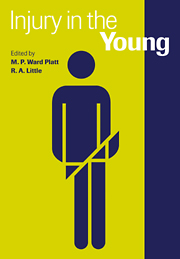Book contents
- Frontmatter
- Contents
- List of contributors
- Editors' Preface
- 1 The epidemiology of trauma involving children
- 2 Emergency room requirements for children
- 3 Child deaths in Accident and Emergency
- 4 Immediate life support
- 5 Evaluation of injury in children
- 6 Injuries of the developing brain
- 7 Wound healing in children
- 8 The lung after injury in children
- 9 Metabolic and endocrine stress responses to surgery
- 10 Head injury in children
- 11 Near drowning
- 12 The acute response to burn injury in children
- 13 Nutritional support of the severely burned child
- 14 Recovery, rehabilitation and the neuropsychological sequelae of head injury
- 15 Children's rights and child protection
- Index
13 - Nutritional support of the severely burned child
Published online by Cambridge University Press: 18 September 2009
- Frontmatter
- Contents
- List of contributors
- Editors' Preface
- 1 The epidemiology of trauma involving children
- 2 Emergency room requirements for children
- 3 Child deaths in Accident and Emergency
- 4 Immediate life support
- 5 Evaluation of injury in children
- 6 Injuries of the developing brain
- 7 Wound healing in children
- 8 The lung after injury in children
- 9 Metabolic and endocrine stress responses to surgery
- 10 Head injury in children
- 11 Near drowning
- 12 The acute response to burn injury in children
- 13 Nutritional support of the severely burned child
- 14 Recovery, rehabilitation and the neuropsychological sequelae of head injury
- 15 Children's rights and child protection
- Index
Summary
Introduction
Children and adolescents have gained the most from improvements in burn care. Modern techniques have made it unlikely that any child will succumb to burn injury even if it is associated with a significant smoke inhalation injury. Table 13.1 shows an increase in the size of burn associated with a 50% mortality from 49% body surface area (BSA) to 98% BSA. (Muller & Herndon, 1994). This remarkable achievement has been accomplished by the development of specialised burn centres, which in turn have fostered basic and clinical research. Appropriate fluid resuscitation has decreased early deaths from acute renal failure to a negligible level. Control of sepsis with early, total excision of full-thickness burn wounds combined with topical antimicrobial therapy and rapid wound closure has promoted survival. Prolonged survival unmasked a hypermetabolic, protein catabolic state that can be attenuated by appropriate nutritional support. This chapter describes the hypermetabolic response which follows injury; discusses the metabolic, wound healing and immunomodulating aspects of nutritional support of a severely injured child; and expands on pharmacological manipulations of the hypermetabolic response which allows better use to be made of provided nutrients.
Response to injury
The response to any injury is similar and varies only in its extent and duration. In this respect, burn is a good model of injury as the extent of injury is quantifiable and recovery is often delayed for many weeks, allowing investigation (Vaughan, et al., 1990).
- Type
- Chapter
- Information
- Injury in the Young , pp. 236 - 262Publisher: Cambridge University PressPrint publication year: 1998



